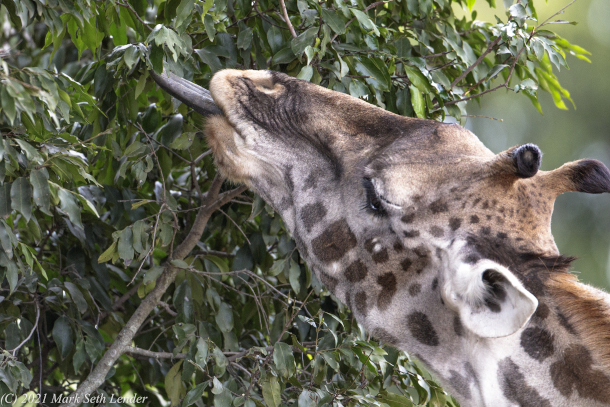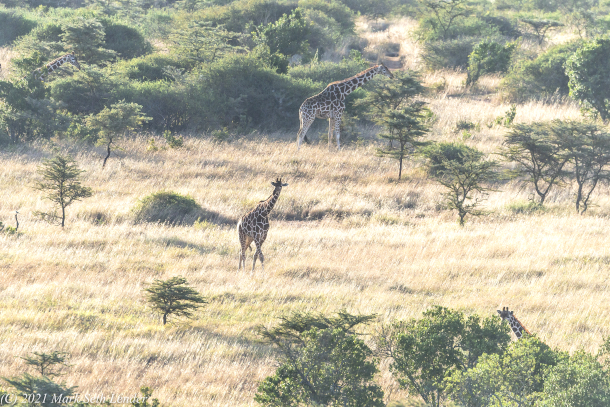The Agreement: Maasai Giraffe in the Highlands of Kenya
Air Date: Week of October 1, 2021

A giraffe extends her long “blackberry-ice-cream tongue” to grasp commiphora leaves. (Photo: © Mark Seth Lender)
Healthy ecosystems tend to seek balance and in the highlands of Kenya, this dynamic plays out in a tacit agreement between giraffe and their leafy diet. Living on Earth’s Explorer in Residence Mark Seth Lender brings us this commentary.
Transcript
CURWOOD: It’s Living on Earth, I’m Steve Curwood.
BASCOMB: And I’m Bobby Bascomb
Healthy ecosystems always seek balance and, in general, any creature that doesn’t comply won’t last long. Living on Earth’s Explorer in Residence, Mark Seth Lender, has this example of a tacit agreement for survival between species in the highlands of Kenya.
The Agreement
Maasai Giraffe
Laikipia Plateau
LENDER: At a grove of commiphora trees giraffe are grazing. They will eat acacia also but the commiphora have no thorns. They reach their necks into the rooftop of the grove. The day is cool and light.
Lean and languid, giraffe move about. Their movements are softness, the patination of their skin, concentric watery shapes like ripples in daubed paint white to light ochre to a center of raw umber, as tempting to the eye is puddles to a child. They are vibrant and alive and as apparent as a forest. Even behind a specter of branches, tangled and dark, they cannot pretend to hide.
But at a distance, at the edge of the woods passing through sun and shade it is impossible to tell, if the herd is in among the trees or in front. How far is also confusing. And with their long legs and long stride, how fast.
Exactly the things a predator watching needs to know.

Giraffe herd grazing on commiphora (Photo: © Mark Seth Lender)
And not knowing, more often than not, will leave them alone.
A giraffe extends her blackberry-ice-cream tongue as dexterous as index and thumb. It wraps around a stem high in the crown. The leaves rustle. She draws them into her wrinkled mouth. Her face furred and furrowed she is not young and the leaves are sweet to her.
And yet she will not stay. She will not eat only of this one tree nor continue in this single place. None of them will, not long enough to nourish much less to staunch their hunger.
Because, tree and giraffe hold an agreement: Do not harm me.
The tree bitten to the quick will make itself bitter as bile. And send a warning through the air, an invisible semaphore too thin to be detected except by other trees, downwind, who will sense and heed the warning; and then they too will make themselves impossible to eat. So, giraffe refrain though the leaves of the grove are plump and green and good. Which makes for a movable feast and for the tree means not being brought to grief but only a pruning. Perhaps this is what the tree needs for the sake of the thick new growth that will come. Or if not needs, at least endures at no great price.
And so each kind, giraffe and tree, can and will, continue.
BASCOMB: That’s Living on Earth’s Explorer in Residence, Mark Seth Lender.
Links
Living on Earth wants to hear from you!
Living on Earth
62 Calef Highway, Suite 212
Lee, NH 03861
Telephone: 617-287-4121
E-mail: comments@loe.org
Newsletter [Click here]
Donate to Living on Earth!
Living on Earth is an independent media program and relies entirely on contributions from listeners and institutions supporting public service. Please donate now to preserve an independent environmental voice.
NewsletterLiving on Earth offers a weekly delivery of the show's rundown to your mailbox. Sign up for our newsletter today!
 Sailors For The Sea: Be the change you want to sea.
Sailors For The Sea: Be the change you want to sea.
 The Grantham Foundation for the Protection of the Environment: Committed to protecting and improving the health of the global environment.
The Grantham Foundation for the Protection of the Environment: Committed to protecting and improving the health of the global environment.
 Contribute to Living on Earth and receive, as our gift to you, an archival print of one of Mark Seth Lender's extraordinary wildlife photographs. Follow the link to see Mark's current collection of photographs.
Contribute to Living on Earth and receive, as our gift to you, an archival print of one of Mark Seth Lender's extraordinary wildlife photographs. Follow the link to see Mark's current collection of photographs.
 Buy a signed copy of Mark Seth Lender's book Smeagull the Seagull & support Living on Earth
Buy a signed copy of Mark Seth Lender's book Smeagull the Seagull & support Living on Earth

